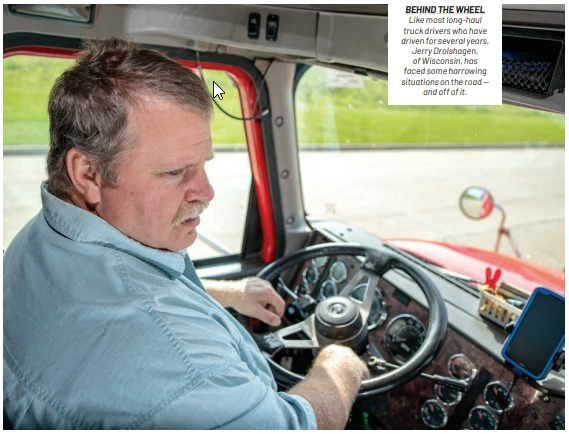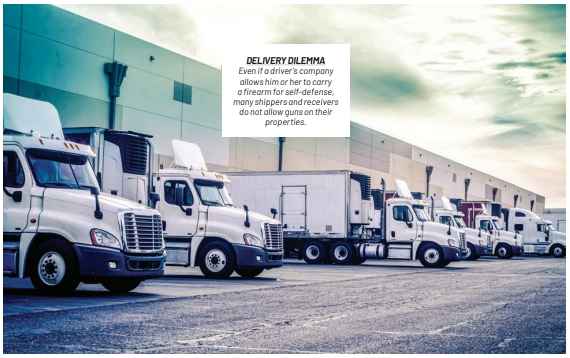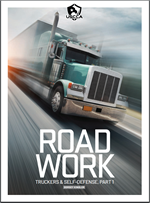Amos Phillips flipped on his right-turn signal and eased the brakes as he pulled his truck off Interstate 15 and onto the Exit 80 offramp at Fort Hall, Idaho.

The gruesome aftermath of the 2018 attack on truck driver Amos Phillips is a graphic illustration of the serious risks truckers face in their travels.
It was Sept. 2, 2018 — the day before Labor Day — and the 64-year-old trucker was “empty,” having hauled a load of railroad crossing parts from Missouri to a receiver 15 miles south of Fort Hall in Pocatello, Idaho.
Multi-state drives like the one he had just completed were part of what Phillips enjoyed most about his job — seeing the country. Originally from Peoria, Illinois, he’d been to every state in the Lower 48, save for Oregon, in his 30 years as a trucker. There were hassles, of course, but the travel and the freedom of the road suited him just fine.
Phillips navigated his 2000 Freightliner Cascadia into the TP Gas & Truck Stop on the Shoshone-Bannock Tribes’ Fort Hall Reservation, backed into one of the long, narrow spaces, and took himself off the drive line. It was a pleasant evening, with temperatures in the 70s, so Phillips decided to walk to the nearby Fort Hall Casino to try his luck at the blackjack tables.
A few hours later and $100 poorer, Phillips walked back to his sleeper cab. He doesn’t drink alcohol because of his Type 2 Diabetes, so he clearly remembers falling asleep listening to the Willie’s Roadhouse channel on SiriusXM satellite radio.
Around 2:30 a.m., Phillips awoke with a start to the sounds of a young man forcibly breaking into the cab of his truck. The intruder, holding rocks in both of his clenched fists, demanded money. Before Phillips could react, the man attacked.
When he came at me, I didn’t really think he would do it. After he started, all I could think about was getting him the hell off my truck.
The plan to do so very well might have involved the Ruger Security-Six revolver Phillips had previously carried for self-defense, but he stopped carrying it in his truck after he was told that truckers are prohibited from possessing firearms by federal law — an all-too-common misconception.
So instead, Phillips, who stands 5 feet, 10 inches tall and weighs 200 pounds, tried to get at the man’s eyes. Not knowing if he was successful (and still under attack), Phillips then grabbed onto the attacker’s “privates” and pushed him out the door with his feet. The man ran off into the night.
The beating was heinous. Phillips was hospitalized at Portneuf Medical Center for three days following the attack, followed by another four days of hospitalization back home in Missouri. He was left with a broken nose, a broken cheekbone, a seizure-inducing blood clot in his brain and thousands of dollars of medical bills for which he had no insurance.
Phillips’ trucking company, Missouri-based JWE Inc., sent a driver to Idaho to pick up Phillips’ rig. The driver found two bloody rocks that the Fort Hall Police Department had left in the cab.
IN A NUTSHELL
For a variety of reasons, it’s difficult for over-the-road truck drivers to protect themselves with firearms:
- While no exact figure exists, the majority of trucking companies, including virtually all the mega-carriers like Swift Transportation, Schneider and C.R. England, prohibit drivers from carrying firearms.
- Even if a driver has his or her employer’s permission (or is willing to break company rules), that driver still has to contend with a mishmash of laws that vary dramatically from state to state. Breaking the gun laws in a state like New Jersey, for example, can result in substantial prison time.
- Many shippers and receivers, and nearly all nuclear facilities, Indian reservations, military bases and international ports, prohibit firearms.
- Lastly, there is the persistent-yet-unfounded belief that truckers are federally prohibited from carrying firearms.
At the same time, truck driving is one of the top 10 most dangerous professions, according to the U.S. Bureau of Labor Statistics.1 The number of total fatal injuries in the category of “truck transportation” was 599 in 2017, the last year with complete data available. While the majority of those fatalities were the result of vehicle accidents, seven of them were homicides, with five of those seven being the result of shootings.
A December 2016 survey on truckers and personal safety by Overdrive Magazine found that 76 percent of respondents have felt they were in danger while parked, delivering or driving, while 35 percent reported having been forced to use a form of self-defense while truck driving.2
Despite the dangers, truck driving is also one of the most vital occupations in the country according to analyst Steve Tam, vice president of ACT Research. “If for some untoward reason we were to shut the trucking industry down,” he said, “the U.S. economy would literally come to a grinding halt. Probably within less than a week.”
If you look at the dollars and cents of it, Tam said, about $1 trillion in freight is shipped in the United States on an annual basis. Trucking handles about 80 percent — $800 billion — of that total. In terms of weight, more than 16 billion tons of freight are shipped each year, which amounts to a little over 11.5 billion tons being moved around the country by truck.
“And as much as we love the railroads,” Tam said, “I don’t know about you, but I don’t have a rail siding coming up to my house. Or my Kroger. Or my Walmart. Or any place that I go to get the stuff I need. I am entirely dependent on the trucks’ ability to deliver that freight.”
The sheer necessity of the trucking industry is something most people overlook, according to Cody Willey, a 26-year-old driver with Brady Trucking, of Vernal, Utah. He said truckers are “the red blood cells of the country,” willing to go anywhere, 24/7, no matter what.
“Unfortunately, there’s a lot of parts of this country that are not doing well,” he said. “But they still need groceries. They still need clothes, school supplies and fuel for their cars. So, truckers are still going there.”
SEEKING SAFETY
It’s hard to pinpoint where a truck driver is most vulnerable. While most pickups and deliveries take place in urban areas, over-the-road drivers routinely travel through rural areas where help is nowhere near. Consider the case of Tony McCoy, who found himself the victim of arson in August 2017. The lease operator had stopped at a small truck stop at Mile Marker 5 on I-93, just north of the New Hampshire-Massachusetts state line. He went inside to update his iPad with the complimentary Wi-Fi. When he came back outside, he found that someone had torched his $250,000 Volvo truck.
I don’t know why someone would do that. I’m African American. You hardly ever see [someone like me] driving a truck. I survived. The truck didn’t. But it was insured.
Major cities with their out-of-control crime issues give truckers pause too. Several years ago, North Carolina-based Gary Harrison was driving out of downtown Chicago on the Skyway around 8:30 a.m. “There was a small car in front of me,” said the GMX Inc. company driver. “Another car passed me and got next to it. I saw a semi-auto come out. Filled the other car with bullets.”
Harrison said the shot-up car bounced off a concrete wall to its right, then veered across both lanes. The side of the car was “all bullet holes and broken glass,” and he could see the driver slumped over behind the wheel. “I called 911,” he said. “They asked if I knew the mile marker and didn’t seem that surprised about it [after he gave them that info], which got me thinking that [the shooter] could have taken me out too because I was a witness.”
Rest areas have their own set of issues. Company driver Jerry Drolshagen was using the bathroom facilities at a rest area four years ago when a man kicked in the stall door. Drolshagen, who goes by the CB handle “Gunsmith,” produced a pistol and sent the man running. The small firm that Drolshagen drives for allows firearms. “I have no idea what he was after,” said the 57-year-old Wisconsin native. “I didn’t give him the chance to explain himself.”
Shippers and receivers are routinely located in less-than-desirable areas. Former driver Guy Smith, also of Wisconsin, found this out the hard way when he was mugged early in his career around the age of 25. He was delivering at a secured warehouse and facing a window of delay time. He wandered across the street to get a sandwich and was attacked in broad daylight in the parking lot of a convenience store. The muggers knew he was a driver because they had watched him pull into the facility from across the street.
“I got beat up pretty bad,” said the 55-year-old. “It’s the main reason I started carrying a pistol. Once you get your ass kicked and get robbed, you know you never want that to happen again.”
And as for the hundreds of truck stops that dot the landscape? The Petros, Flying Js, Love’s, Pilots and scores of independents? They aren’t exactly safe harbors either, as Phillips can attest.

Like most long-haul truck drivers who have driven for several years, Jerry Drolshagen, of Wisconsin, has faced some harrowing situations on the road – and off of it.
THE PARKING ISSUE
The trucking industry has long suffered from a lack of safe parking. Without a parking spot, drivers are forced to make do with freeway ramps and abandoned lots, putting them at increased risk of accidents and crime.
And now, with government-mandated electronic logging devices monitoring hours of service, much of the flexibility of the past has been taken away. Drivers can’t advance a load one minute past their allotted 11 hours of daily drive time, even to find a parking spot, without risking steep fines.
“[A lack of] parking is an epidemic in our industry right now,” said Lewie Pugh, vice president of the Owner Operator Independent Driver Association (OOIDA). “If you have to stop, you have no choice now. Congress is going to have to step up and do something about it. This is beyond the private sector.”
Congress did address the issue in 2012 with the MAP21 highway bill that included “Jason’s Law,” named after 35-year-old truck driver Jason Rivenburg, who was shot dead for $7 while parked at an abandoned South Carolina gas station. The inclusion, championed by Rivenburg’s widow, Hope Rivenburg, required the Department of Transportation to address the national truck parking shortage at public and private facilities along U.S. highways.
The first Jason’s Law truck parking survey released in 2015 found that most states lacked truck parking capacity, especially states along major corridors with high truck volumes, such as I-95, I-40, I-80, I-10 and I-81. A second study is set to be released by early 2020, but according to Pugh, such studies are pretty much worthless.
I don’t know how many meetings I’ve been on since I came on to OOIDA. It’s the same problem. The government does research and studies but never does anything with the information. We need to pour pavement. Just somewhere to park the trucks.
Florida truck driver Desiree Wood has taken up the mantle of parking activist since her friend Hope Rivenburg took a step back to focus on her young children. Wood attends meeting after meeting in an attempt to spread the message to anyone who will listen.
We don’t expect our armed service members to go fight a war for us and then go fend for themselves at night. Truck drivers serve this country every day. And they deserve a place to stop and sleep where they won’t be sitting duck[s].

Even if a driver’s company allows him or her to carry a firearm for self defense, many shippers and receivers do not allow guns on their properties.
THE BIG TICKET
It was a lack of safe parking that led to Wood becoming the victim of another trend plaguing the trucking industry: cargo theft.
On July 3, 2018, she was hauling a load of Campbell’s Soup from North Carolina to the Miami Publix distribution warehouse. Knowing there was little parking in South Florida, she called it a night in West Palm Beach, close to where she lives.
Wood carefully parked her truck at a closed Winn Dixie and went home 5 miles away to get some sleep. When she got back to her truck a little after 3:30 the next morning, she was shocked to find her $13,000 trailer and its $65,000 in cargo gone.
“The tractor was sideways,” she said, “and had been yanked out of the way of the trailer that weighed close to the maximum allowed with 43,000 pounds of soup product. They attempted to steal my tractor too, but my [electronic logging device] prevented it.”
DNA swabbed from the tractor’s fifth wheel led Palm Beach Police to 53-year-old Guillermo Arteaga, who was charged with larceny of $20,000 to $100,000, burglary of an unoccupied conveyance and grand theft of a motor vehicle. “Law enforcement told me dealing with cargo theft is a full-time job in South Florida alone,” Wood said. “These rings are very sophisticated.”
Indeed, a Quarter 1 2019 analysis by CargoNet found that trailer burglaries were becoming the preferred method of cargo theft.3 It’s a pattern that continued into the second quarter, which saw an estimated total of $22.9 million in cargo stolen across the United States and Canada.4 California, Florida and Texas were the top three states for such crimes.
COMPANY POLICY
Considering the high-value loads and frequent trips to crime-ridden areas, it would seem logical to arm overthe-road truck drivers. But virtually all major trucking companies prohibit firearms outright, and it’s difficult to get a reason why.
Swift Transportation, J.B. Hunt Transport, Schneider, CRST International, Knight Transportation, C.R. England and US Xpress did not reply to interview requests. Representatives of the American Trucking Associations (ATA), an organization that represents the interests of these large firms and others, declined to be interviewed. Sara Edmondson, the safety officer for medium-sized Great Plains Transportation out of Fargo, North Dakota, was willing to go on the record, however.
“Every trucking company has some sort of variation of safety officer,” she said. “If a customer is looking at us to haul freight, and we have no safety structure? It’s a no. The same goes for poor safety records. We’re not going to get that business.”
Edmondson said that if her company doesn’t comply with rules and regulations, it could lose its Department of Transportation number and go out of business. “A lot of my job is writing reports,” she said. “What was the cause of the accidents we were in? And then attacking those causes and trying to eliminate them. Every time a driver leaves our yard, risk assessment is involved.” When asked why her company bans firearms, she mentioned the liability issues the company’s drivers face traveling between all of the lower 48 states. But she didn’t elaborate beyond that.
A commonly held belief is that trucking companies would be uninsurable if they were to allow drivers to carry firearms, but Matt Van Syoc doesn’t believe that is the case. He’s a broker with Indiana-based insurance firm Marvin Johnson & Associates, which holds a policy count of 4,000 and $70 million in premiums.
“When we do our underwriting questions, we never have to ask about firearms,” he said. “We fall back on the policies of the motor carrier. If [it has] a policy in writing that states you have to have a permit and use your weapon responsibly? That’s up to the employer, the motor carrier.” Drolshagen has a less charitable explanation. He believes the reason large trucking companies ban firearms is that they treat their employees so poorly. (It’s true that the annualized turnover rate at large carriers — fleets with more than $30 million in annual revenue — stood at 83 percent, according to recent ATA reports.5)
Drolshagen also has a standing bet with anyone who will take it: $1,000 cash to the first person who can point to the line in the Federal Motor Carrier Safety Regulations Pocketbook that bans firearms.
So far he’s kept his money.
OTHER WEAPONS

Truck driver Jerry McDowell, of Texas, carries a hammer in the door of his truck for odd jobs and self-defense.
Of course, firearms aren’t the only way truck drivers can fend off a burglar or would-be attacker. Tire thumpers, cans of wasp spray, tasers and pocketknives are used by truckers as self-defense weapons with varying degrees of success.
Jerry McDowell, a 78-year-old former iron worker, keeps his old iron-working hammer in the door of his truck, just in case. He also kept a tomahawk in his cab
until a police officer who pulled him over told him to get rid of it.
“I bet you’re going to tell me you use this for work,” the officer said.
The problem is, in the eyes of the law, many of these alternatives are no different than using a handgun in self-defense. No matter what tool is used, an act of deadly force in self-defense — and any use of knives, blunt-force tools and guns would fall under this category — should be legally justifiable. Self-defense expert Massad Ayoob perhaps puts it most succinctly: “Deadly force is justified only when undertaken to prevent imminent and otherwise unavoidable
danger of death or grave bodily harm to the innocent.”
Less-lethal alternatives to firearms, such as tasers and pepper spray, aren’t deadly force but must nonetheless only be used when legally justified, lest the user find himself or herself charged with assault. [Editor’s Note: While wasp spray might fall under the “less-lethal” category, it is a terrible, and perhaps deadly, idea to use a product designed to kill insects to protect yourself from a violent attack. Pepper spray is a much more effective and legally defensible less-lethal self-defense option and barely more expensive.]
“Before you take physical action,” said Attorney Adam H. Rosenblum, “you really have to think about if you’re truly acting in self-defense or getting swept up in the emotions of the moment. What one individual might consider self-defense, a prosecutor or judge might view as aggression.”
Rosenblum cited the recent example of Daniel Eric Orchard, a truck driver arrested in Laredo, Texas, for spraying insecticide in a motorist’s eyes after a road-rage incident. The 48-year-old was charged with assault for the incident. “There can be a fine line between defense and offense,” Rosenblum said.
FEDERAL PROTECTION
It’s “absolutely ridiculous” to Willey that there is no federal law protecting truck drivers who wish to keep a firearm in their cabs, especially drivers with hazmat endorsements, such as himself.
“We are already fingerprinted and passed FBI and TSA checks,” he said. “We’re tracked everywhere we go with ELDs. We need to be medically certified every couple of years, or every year, depending on your health. We’re subjected to some of the most frequent random drug and alcohol testing. Honestly, how much more could you possibly do to prove we’re upstanding citizens?”
Willey pointed out that drivers of armored cars are allowed to carry firearms. “I’m sure there are some wild exceptions,” he said. “But, in reality, how much money are those guys carrying around? A couple hundred thousand dollars’ worth? I’ve hauled loads of Victoria’s Secret. What’s the retail value on that? It’s not heavy, and it’s packed floor-to-ceiling, front-to-back. That’s not a cheap store.”
FORCED RETIREMENT
As for Phillips, he can be found these days at his home in Missouri by the Lake of the Ozarks, wrenching on two Willys Jeep Pickups. He lives off disability and his wife’s income because he can no longer drive truck. His doctor said he had to be seizure-free for five years before getting his Commercial Driver’s License (CDL) reinstated. By that time, he’ll be nearly 70 years old.
“For the most part, he retired me, whether I wanted to or not,” Phillips said of his attacker. A suspect, Stormy Adakai, was eventually arrested by Tribal Police. There is more information about his case later in this series.
Phillips feels strongly that things would have turned out differently had he been carrying a firearm. “There’d be no issue anymore,” he said. “I’d have used it.”
ENDNOTES
- U.S. Bureau of Labor Statistics, “Fatal Occupational Injuries Counts and Rates By Selected Industries, 2016- 17,” Table 4,
https://www.bls.gov/news.release/cfoi.t04.htm. - Carolyn Magner, “Danger zone: Truckers stick to their guns despite questions about firearm laws, Overdrive research reveals,” Overdrive Magazine, Feb. 14, 2017, https://www.overdriveonline.com/danger-zone-truckersstick-to-their-guns-despite-state-variance-in-gun-lawsoverdrive-research-reveals/.
- CargoNet, “First Quarter 2019 Cargo Theft Trends,” https://www.cargonet.com/news-and-events/cargonet-in-the-media/first-quarter2019-cargo-theft-trends/.
- CargoNet, “Second Quarter 2019 Cargo Theft Trends,” https://www.cargonet.com/news-and-events/cargonet-in-the-media/first-quarter2019-cargo-theft-trends/.
- Sean McNally, American Trucking Associations, “Turnover Rate at Large Truckload Carriers Jumped in First Quarter,” July 17, 2019, https://www.trucking.org/article/Turnover-Rate-at-Large-Truckload-Carriers-Jumped-in-First-Quarter.
This is Part One of a a five part series on Truckers & Self-Defense by the USCCA written by Dorsey Kindler. If you appreciate his work, the entire series can be downloaded here.
This fine self-defense article is brought to you by the
USCCA – Self-Defense Education, Training and Legal Protection for Responsible Gun Owners.
Visit https://www.uscca.com for more details
877-677-1919



